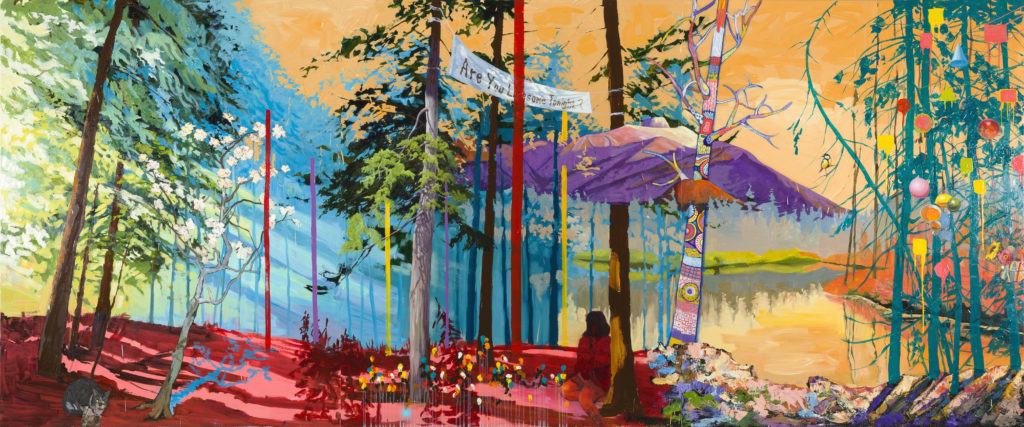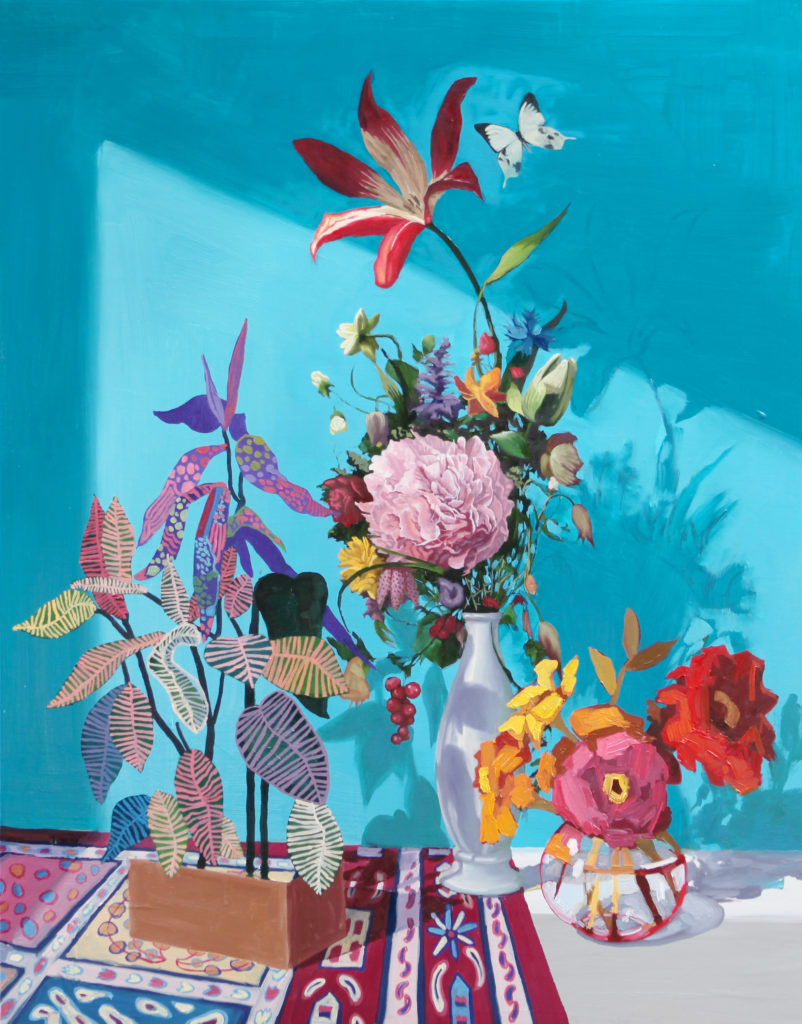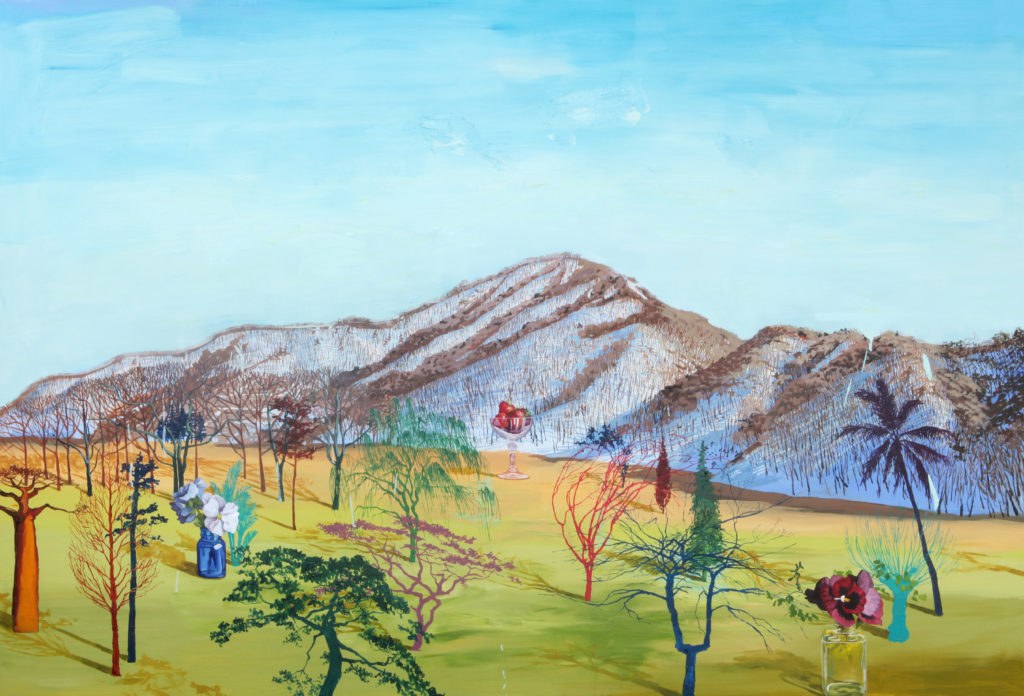21 Mar 2019
Interview
SANGKYUN KIM: LOOKING BEYOND THE SURFACE

Are You Lonesome Tonight, oil on canvas, 2018.
Sangkyun Kim is a visual artist from South Korea working mainly in landscape painting. The surface of the painting is his subject matter, while he also wishes to create worlds and a present that exists behind it. He wants to extend our perspective and our world’s limitations, by creating images that are associated with one another and reconstructing his paintings from seemingly unrelated information. He believes that using flashy colours and old-fashioned imagery is a forceful way to get the viewer to look beyond the painting’s surface. As a starting point for his landscapes he uses gathered imagery from the internet and also his personal photographic archives. While at HIAP, Sangkyun will be working with large rolling paper, so he can work without interruptions. Sangkyun is working at HIAP’s Cable Factory studios until May 30th, 2019.

Still life #3, oil on canvas, 2018.
AA: Your paintings are really bright and colourful. How did this style develop?
SK: The paintings are indeed bright and colourful, like a stopped moment, exaggerated and splendid. They are like a tourist photograph of the best tourist spot on a clear day, or like an artificial flower.
In my work, I use colours and materials that bring out the artificiality of the subject matter. The paintings are artificial in subject: media scenes and over-stylised landscapes or indoor spaces.
I use bright colours for the same reason I use painterly clichés. The colours and the clichés, which in my paintings are realised and repeated, interfere with the simple and straightforward enjoyment of my paintings. The clichés serve to distract the viewer away from the surface.
AA: What qualities make a painting interesting?
SK: When I look at another artist’s exhibition, I observe what has changed from the previous work. I think change is important, it means the artist is still enjoying making work.
AA: Are the landscapes depicted in your paintings imaginary or real, or perhaps both?
SK: My work has a reference image. The images I refer to include pictures taken by myself, pictures on the internet, and media cut-outs. These images are rearranged, combined and worked on in my work so in the end they become imaginary. The original images are banal. Their rearrangement is indeed a superposition of clichés. I want the clichés to be so obvious, that the audience will know to stare beyond them. I also try to look behind the clichés myself at all times.
AA: Where is your favourite place to paint and why?
SK: I do not have a favourite landscape or object. However, when I see any landscape or object, that can start a process within my imagination, where I create the perfect subject matter in my mind. My past video work is a visualisation of this process.
AA: The dimensions in your paintings are often distorted, creating an uncanny feeling. What are you trying to accomplish by setting such an anxious mood?
SK: I am glad you see ‘uncanny’ in my work. Many people have said that my paintings are not uncanny or uncomfortable.
The fact that I work in painting gives me the freedom and the opportunity to distort reality. Paintings are just surfaces, that consist of colour and shape. I am a painter who creates visual images, yet I often feel the limitations of these images. The conflict I believe is what you mean by ‘uncanny’.
If the audience sees the ‘uncanny’ in my work, he will try to find the reason behind it. He/she will notice that the images are a montage and will realise that what he is seeing is just the surface of the picture, forcing him/her to look for more meaning within.
AA: How does the approach to painting a small work differ to the approach to painting a large work? I understand that at HIAP you will be working on a large rolling paper.
SK: I chose a large rolling paper or cloth. The reason is that I can work continuously and uninterrupted. However, the subject or subjects depicted will be non-continuous. I will assemble and rearrange objects and moments in time within a single, uninterrupted work.
I will paint objects that are visible in Finland at all times. The paintings, I hope, will then become both continuous and discontinuous. I think discontinuity is more important in my work, because it is an attempt to focus on the moment. Moments are unique and discontinuous.
AA: What are your plans for your residency at HIAP? Will the central Helsinki and Suomenlinna landscapes find their way to some of your paintings?
SK: I will continue working on landscape painting, on large rolling paper or cloth. Suomenlinna is, of course, part of my experience in Finland. I expect to find a part of Suomenlinna in my paintings in the future.
Read more:

Landscaping, oil on canvas, 2018.
